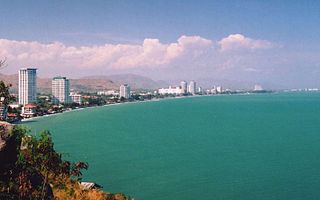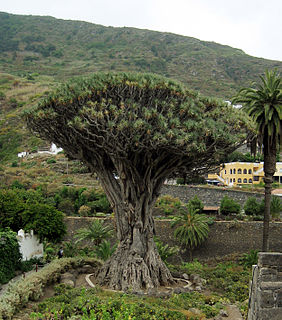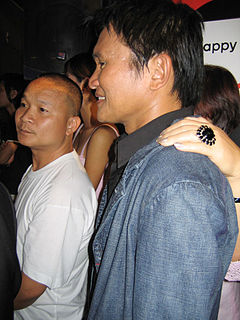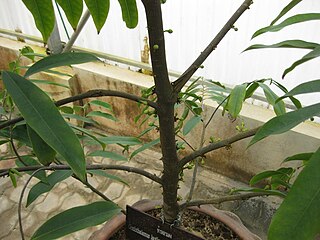
Prachuap Khiri Khan is one of the western provinces (changwat) of Thailand. It is in the northern part of the Malay Peninsula, some 240 km (149 mi) south of Bangkok. Neighboring provinces include Phetchaburi to the north and Chumphon to the south. To the west, it borders Tanintharyi Region of Myanmar.

Nonthaburi is one of the central provinces (changwat) of Thailand, established by the Act Establishing Changwat Samut Prakan, Changwat Nonthaburi, Changwat Samut Sakhon and Changwat Nakhon Nayok, Buddhist Era 2489 (1946), which came into force on 9 May 1946 (Thursday).

Hua Hin is one of eight districts (amphoe) of Prachuap Khiri Khan province in the northern part of the Malay Peninsula in Thailand. Its seat of government, also named Hua Hin, is a beach resort town. The district's population was estimated at 65,983 in December 2019 by the Bureau of Registration Administration in an area of 911 km2 (352 sq mi). By road, it is 199 km (124 mi) south-southwest of Bangkok.

Dracaena is a genus of about 120 species of trees and succulent shrubs. The formerly accepted genera Pleomele and Sansevieria are now included in Dracaena. In the APG IV classification system, it is placed in the family Asparagaceae, subfamily Nolinoideae. It has also formerly been separated into the family Dracaenaceae or placed in the Agavaceae.

Khao Yai National Park is a national park in Thailand. Established in 1962 as Thailand's first national park, it is the third largest national park in Thailand.

Khao Sam Roi Yot National Park is a marine national park in Kui Buri District, Prachuap Khiri Khan Province, Thailand. It covers 98.08 km2, of which 20.88 km2 are marine areas. The park was established in 1966, and was the first coastal national park of Thailand. The park includes Thailand's largest freshwater marsh.

Panna Rittikrai or birth name Krittiya Lardphanna was a Thai martial arts action choreographer, film director, screenwriter, and actor. The head of the Muay Thai Stunt team, he is best known for his work as a martial arts and action choreographer on the 2003 film Ong-Bak: Muay Thai Warrior and 2005's Tom-Yum-Goong, starring Tony Jaa, whom Panna mentored.

Tarutao National Park consists of 51 islands in the Strait of Malacca, off the coast of Satun Province of southern Thailand. The Tarutao National Park consists of two island groups: Tarutao and Adang-Rawi, which are scattered from 20 to 70 kilometres' distance from the south-westernmost point of mainland Thailand. The park covers an area of 1,490 square kilometres. The southernmost end of the park lies on the border with Malaysia, just north of Langkawi. Tarutao became Thailand's second marine national park on 19 April 1974. The coastal Khao Sam Roi Yot National Park had been designated in 1966.

Pak Chong is the westernmost district (amphoe) of Nakhon Ratchasima province, northeastern Thailand, and the main point of entry into Isan as the main road and rail lines cross the Dong Phaya Yen Mountains into the region. It is a popular tourist destination, especially among weekenders from Bangkok, and is home to many resorts and touristy attractions, in addition to the main entrance into Khao Yai National Park.

Kaeng Khoi is a district (amphoe) of Saraburi province in central Thailand. Located on the bank of the Pa Sak River amid the surrounding hills of the Dong Phaya Yen Mountains, its main town of the same name developed throughout the 19th century, first as a trading post on the river and the passageway into the Northeast, then as a railway town when the Northeastern Railway was built through the town at the end of the century. Today, it has developed into a major industrial centre, especially of cement manufacturing.

Namtok Chat Trakan National Park is a national park located in Chat Trakan and Nakhon Thai Districts of Phitsanulok Province of Thailand, established in 1987. It encompasses Lam Kwae Noi, Daeng and Chat Trakan forests a substantial portion of Chat Trakan District.

The Thai highway network follows the left-hand traffic rule of the road. The network is the twin responsibility of the Department of Highways, and the Department of Rural Roads, under the oversight of the Transportation ministry of Thailand. Public highways are also called public roads, especially when part of urban streets. The network spans over 70,000 kilometers across all regions of Thailand. Most are single carriageways. Dual carriageways have frequent u-turn lanes and intersections slowing down traffic. Coupled with the increase in the number of vehicles and the demand for a limited-access motorway, the Thai Government issued a Cabinet resolution in 1997 detailing the motorway construction master plan. Some upgraded sections of highway are being turned into a "motorway", while other motorways are not being built from highway sections.
Living River Siam is a Thai non-governmental organization (NGO) which analyzes the impact of Thailand's various dam projects and coordinates the research of indigenous peoples to give Thai villagers the power to document the influence of local rivers and dams. Founded in 1999, it gained prominence during the Pak Mun Dam study period in 2001, when it developed a method for instructing villagers on how to document the effects of the dammed river on their lives. When the Thai government proposed other dam sites, Living River Siam took its research methods to the villages surrounding those sites as well. Today, the organization works with other NGOs in Southeast Asia to counter government-sponsored research that encourages dam construction.

Thap Lan National Park is in the Sankamphaeng Range in Prachinburi, Nakhon Ratchasima Provinces, Thailand. Established as a national park on 23 December 1981, it was the country's 40th national park. Its attractions include Lan Forest and Recreational Garden (ป่าลานและสวนพักผ่อนหย่อนใจ); Namtok Thap Lan (น้ำตกทับลานหรือน้ำตกเหวนกกก); Thap Lan Reservoir (อ่างเก็บน้ำทับลาน); Namtok Huai Yai (น้ำตกห้วยใหญ่); Lam Mun Bon Dam (เขื่อนลำมูลบน); Hat Chom Tawan (หาดชมตะวัน).

Wachirabenchathat Park, or often spelled Vachirabenjatas Park, also popularly known as State Railway Public Park is a name of public park in Chatuchak district, Bangkok, Thailand. The park borders on the Queen Sirikit Park and Chatuchak Park, and it is also the largest park of the complex, bounded by Kamphaeng Phet 3 road and Kamphaeng Phet 2 road with Soi Nikhom Rotfai Sai 1 near PTT Head Office and Ministry of Energy. It is one of the most popular parks in Bangkok.
In Thailand are a growing number of Montessori schools and organizations. The first Montessori Schools since 1995 have been founded in Phuket by Willem van Benthum, founder of the Rawai Progressive International Montessori School in Phuket (1996), in Pattaya Naklua and by parents in Chiang Mai. But the history of Alternative education in Thailand and the influence of Maria Montessori to several might date back to much earlier years.

Goniothalamus laoticus is a species of plant in the family Annonaceae. It is native to Laos and Thailand. It was originally described by the French botanists Achille Eugène Finet and François Gagnepain using the basionym Mitrephora laotica. In Thailand it is commonly called Khao Lam-dong and is used as a traditional medicine.
Nam Pat Wildlife Sanctuary is a wildlife sanctuary in Ban Khok, Fak Tha and Nam Pat districts of Thailand's Uttaradit Province. The sanctuary covers an area of 508 square kilometres (196 sq














